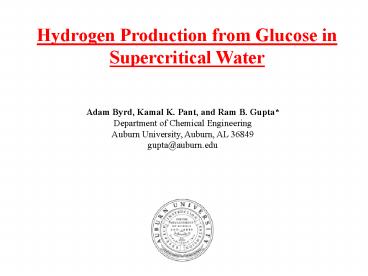Adam Byrd, Kamal K' Pant, and Ram B' Gupta - PowerPoint PPT Presentation
1 / 27
Title:
Adam Byrd, Kamal K' Pant, and Ram B' Gupta
Description:
(1) H2:CO mole ratio of 2:1 is needed (2) Coal gasification only yields H2:CO ratio of 1:1 ... 12 moles hydrogen per mole of glucose. 24 grams hydrogen per 180 ... – PowerPoint PPT presentation
Number of Views:46
Avg rating:3.0/5.0
Title: Adam Byrd, Kamal K' Pant, and Ram B' Gupta
1
Hydrogen Production from Glucose in Supercritical
Water
Adam Byrd, Kamal K. Pant, and Ram B.
Gupta Department of Chemical Engineering Auburn
University, Auburn, AL 36849 gupta_at_auburn.edu
2
Hydrogen Requirements in FT Synthesis of Liquid
Fuels (1) H2CO mole ratio of 21 is needed (2)
Coal gasification only yields H2CO ratio of 11
(3) Need 100 more hydrogen for production of
liquid fuels (4) Carbon-neutral hydrogen is
preferred - Biomass, Solar, Wind
3
Outline (1) Supercritical water (2) Biomass
glucose (3) Apparatus for hydrogen production in
supercritical water (4) Hydrogen production (5)
Future work
4
Biomass Cellulose
Glucose
Strong H-bonding
5
Biomass Lignin
6
Hydrogen from Glucose
Desired Reaction C6H12O6 6H2O ? 6CO2 12H2 12
moles hydrogen per mole of glucose 24 grams
hydrogen per 180 gram of glucose!
Undesired Byproducts CH4 C2H6 CO Acids Aldehydes
7
- Approximate Cost of Hydrogen Produced from
Glucose - Basis 1 kg of Hydrogen
- Reaction for the best case scenario C6H12O6 6
H2O 6CO2 12H2 - That is 180 gram (1 mole) of glucose is needed to
produce 24 gram (12 moles) of hydrogen. - Case I. Based on current glucose prices of
0.23/kg (from Sugar Industry) - Material cost
- To produce 1 kg of hydrogen, glucose needed
(180/24) 7.5 kg - Material cost 0.23/kg-glucose
0.23/kg-glucose x (7.5 kg-glucose/kg-H2)
1.73/kg-hydrogen - Energy cost
- Energy needed 1.322 MJ/kg-glucose 1.322
MJ/kg-glucose x 7.5 kg-glucose/(kg-H2) - 9.915 MJ/(kg-H2) 0.009915 GJ/kg-H2
- Industrial cost of energy 8.3/GJ 8.3/GJ x
(0.009915 GJ/kg-H2) 0.082/(kg-H2) - Equipment cost
- Assume 5 of the material cost 0.05 x 1.73
0.086/kg-H2
8
- Case II. Based on projected future glucose price
of 0.07/kg (from Biomass Industry) - Material cost
- Material cost 0.07/kg-glucose
0.07/kg-glucose x (7.5 kg-glucose/kg-H2)
0.525/kg-hydrogen - Total cost for 100 efficient process
- Cost of 1 kg hydrogen 0.525 0.082 0.086
0.7/kg-H2 - Note Hydrogen is obtained directly at high
pressures from Supercritical Water Process.
Hence, there is no additional compression cost.
Also, biomass automatically depolymerizes in
supercritical water to produce glucose
9
Hydrogen Production in Supercritical Water
- H2O is both a reactant and the solvent
- Direct high-pressure H2 is obtained
- Compact reactors reactions time in seconds
- In-situ separation
- Energy integration
- Possible use of sulfur containing fuels
- Carbon dioxide can be easily sequestered
- Avoids char formation
10
Supercritical Region
Water Tc 374 oC Pc 221 bar ? c 0.375 g cm-3
Pressure ?
Path from liquid to vapor without encountering
a phase transition
Critical Point
Liquid
Solid
Gas
Triple Point
Temperature ?
11
Is Supercritical water different than ambient
water?
12
Supercritical water is like an organic solvent!
Kritzer and Dinjus, Chemical Engineering Journal
(2001), 83(3), 207-214
13
Auburn University H2 Production Apparatus
14
Auburn University H2 Production Apparatus
Feed
Back Pressure Regulator
Furnace
Heat Exchanger
Pump
Phase Separator
He for GC
6-port valve
GC
15
Tubular Supercritical Water Reactor
- Materials
- Inconel-600 (Ni0.73 Fe0.18 Cr0.09)
- Monel-400 (Ni0.67 Cu0.33)
- 316SS (Fe0.66 Cr0.17 Ni0.12 Mo,Mg0.02)
- Diameters
- 1/8outside 1/12 inside
- Lengths
- 0.5, 1, 2 m
16
- Empty-bed (no added catalyst) Reforming of
Glucose - Experimental conditions
- 1 wt glucose, 248 bar, 700 C
Inconel reactor wall provides some catalysis
17
- Reforming of Glucose with Ru/Al2O3 Catalyst
- Experimental conditions
- 1 wt glucose, 248 bar, 700 C, 2 g Ru/Al2O3
With Ru catalyst complete conversion to H2 is
achieved
18
- Carbon in Exiting Liquid
- Experimental conditions
- 1 wt glucose, 248 bar, 700 C
Complete gasification of carbon
19
- Reforming of Glucose with Ru/Al2O3 Catalyst
- More Glucose in the Feed
- Experimental conditions
- 5 wt glucose, 248 bar, 700 C, 2 g Ru/Al2O3
20
- Reforming of Glucose with Ru/Al2O3 Catalyst
- Effect of glucose concentration in the feed
- at 2 second reaction time
- Experimental conditions
- 2 s residence time, 248 bar, 700 C, 2 g Ru/Al2O3
21
- Temperature Effect
- Experimental conditions
- 4 wt glucose in feed, 2 s residence time, 248
bar, 2 g Ru/Al2O3
22
- Typical Product Composition
23
- Conclusions
- Reforming in supercritical water is beneficial
since H2 is produced directly at high pressure,
as demonstrated here for glucose - Reactor wall catalysis is sufficient for
methanol. Ruthenium catalysts is needed for
glucose. - Short reaction time of a few second is enough to
achieve maximum yield of hydrogen.
24
Future Work
- Ultimate goal is to use coal/biomass feed
- Experiments with
- Individual feeds glycerol, hemicellulose,
lignin, cellulose, char, coke, switch grass - Mixed feeds various binary combinations of above
feeds - Testing of Ru and non-Ru catalysts
- For an scalable process, use of non-Ru catalyst
is important - In-situ separation using Pd-Cu membranes
- Available high temperature and pressure can be
utilized to have a good flux of pure hydrogen
product
25
(1) In-situ Membrane Separation of H2
- Palladium membrane inside the supercritical water
reactor
Hydrogen exit
Palladium membrane
Inconel reactor
26
(2) Coal/Biomass Feedstock
- Acquired micronized coal, ground switch grass
- Acquired slurry pump
(from Coal Fillers, Inc.)
(from Haskel Milton Roy)
27
Comments/Questions?
Water is environmentally benign and inexpensive

